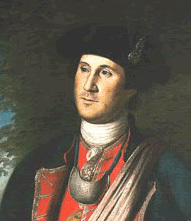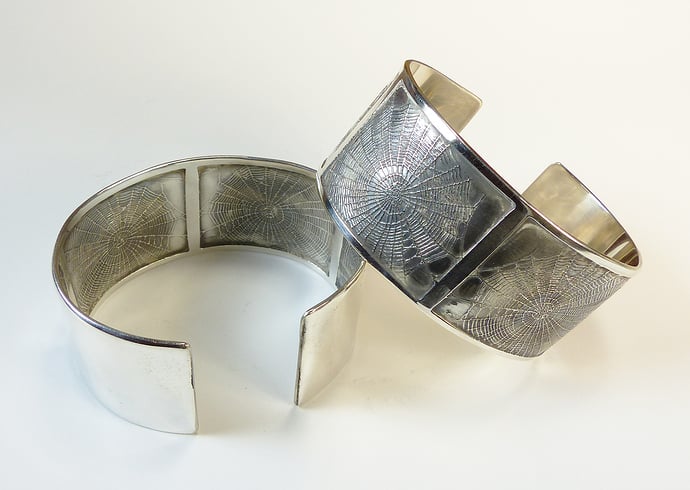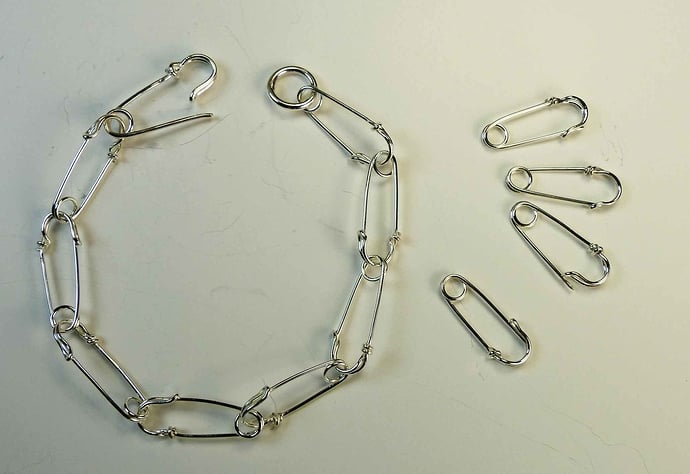These images are pieces of jewelry I made for an art gallery show in Ann Arbor, and they have a decidedly political slant. Probably the right audience for this. The big piece is a gorjet!
Just Beautiful! The ‘gorjet’ piece is amazing, love the clasp also. I particularly love the elegant ‘safety’ pins. Wishing for safety promised, to be obtained. Love the sharing here. Inspirational!
Eileen
Is a Gorjet an artifact? Did you polish it?
Hello Betsy,
Very nice work indeed. Really like the safety pin bracelet!
Judy in Kansas
Gorget is the correct spelling. Sorry about that. The Brexit safety pins are for solidarity.
The gorget was a type of necklace for a British soldier during the colonial era, and descended from armor. I ran for local office in a remote (rural) area of Michigan that chose Trump as president. People were really awful to me, inspiring me to make a gorget to keep from getting my throat cut. It is part of a collection of jewelry I made for an Ann Arbor gallery and I themed the collection “Mood of the Country.” Country refers to the US and to being in the country.
The surface is etched, oxidized and lightly polished. The back for contrast is highly polished. 
George Washington with a gorget!
Back then in history - the lyric phrase “yankee doodle stuck a feather in his cap, and called it “macaroni””. . . Referred to over the top personal attire. That GW in his gorget with the other necklaces is pure 18th century macaroni!
Eileen
in LA where it poured buckets last night (drought, what drought?)
The gorget (from Fr. gorge=throat) was not merely an ornament, it was a badge of rank. Only officers wore a gorget in 18th century armies.
Of course, as mentioned it is descended from the Medieval gorget, plate armor for the throat.
The Wikipedia article on the item is very good.
Fine safety pins, crazy necklace–great. Liked leaf and cuffs. John from Denver
How did you accomplish the pattern for the spider web?
Beautiful work Betsy.
Peace
Greg
Greg – thanks for asking! I found a digital image of an intact cobweb on line and printed it out on an 8.5x11 sheet of paper. I needed to reverse the white lines of the web to black nd eliminate the background. I taped my print out to a window facing the sun, tapes a piece of tracing paper over it, and drew in each line of the cobweb, using a finepoint Sharpie. Then I scanned the tracing via my printer and loaded it into my computer, where I edited it, sized it way down and put it into a word document. I was able to repeat it, flop it and darken it as needed. A graphics artist could probably filter out the background to produce the web in seconds. But I liked the “hand” of the tracing. Took me about a half hour to do this.
Just watched a TV show, Timeless, episode in late 1700’s, Gorgets’ everywhere…
Jim
Thank you for taking the time to respond Betsy! Your process make perfect sense. In the back of my mind I have been wanting to use spider webs in design. I have been looking at using hair spray on webs and then sand witching them between glass.
Should be fun. Merry Christmas
Peace
Greg
Very nice. So the web’s and leaves are etched? I like how they turned out.
It’s always a little rigamaroll transfering patterns but often worth the
time. With computer programs these days it’s so much easier to flip and
manipulate images. Keep up the innovation
Try instrument lacquer,
H. Belen makes the best. (you can buy online)
It’s very thin, dries almost instantly and can easily build multiple coats.
Spider webs are really strong, it’ll be interesting to se how you isolate a section (maybe after spraying a few times, trimming sections that won’t deform unintentionally will be easier.
There are scissors called “Friskers” that are incredibly sharp and cut at the very tip, might help.
I’m loving the idea,
Please keep us all posted.
Thanks, Jim
Beautiful and imaginative. I love the simple elegance of the spider web bracelet. Thank you for sharing your work.

